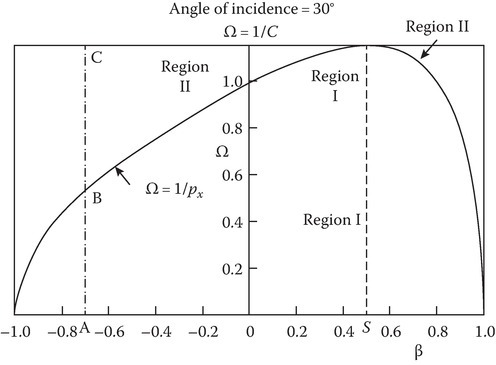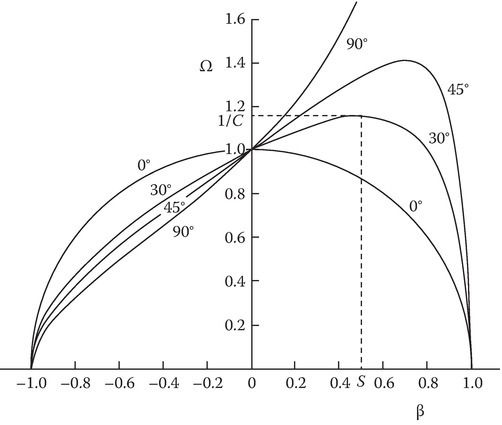]>
Appendix 14E: On Total Reflection of Electromagnetic Waves from Moving Plasmas*
When a plane electromagnetic wave is obliquely incident on a dielectric boundary, there are particular angles of incidence leading to a condition of total reflection. The critical angle is given by arcsin , and, thus, total reflection is not possible from an optically denser medium [1]. The situation for the case of two relatively moving dielectric media was examined by Shiozawa and Kumagai [2]. If the wave traveling in free space is incident on a plasma medium, total reflection can take place under certain conditions; at normal incidence, waves of frequency less than the plasma frequency are totally reflected [3], and, for oblique incidence, the range of wave frequencies for total reflection is generally extended [4]. The purpose of this appendix was to investigate how this frequency range is modified by the motion of the plasma medium that may be isotropic or uniaxially anisotropic. Both parallel and perpendicular polarizations of the obliquely incident wave are considered. A few workers [5,6,7] have also touched upon total reflection in a limited manner in their treatment of reflection and transmission of electromagnetic waves from moving media.
Consider a plane electromagnetic wave obliquely incident (x–z-plane of incidence) on a plasma half-space moving relativistically through free space. Let the transmitted wave in the moving plasma (Σ′) have the exponential variation
where q′ is the root of the dispersion equation in Σ′ and may be determined for uniaxial z [8] (infinitely strong magnetostatic field along the z-axis), uniaxial x [9], uniaxial y, or isotropic plasmas [10] in the usual manner by solving Maxwell’s equations in Σ′. The notation used are the same as in Reference 8.
In the laboratory frame (Σ), the form of the transmitted wave may be written as
The wave vector kP and frequency ωP of the plasma wave as seen from the laboratory frame (Σ) are related to those in the rest frame (Σ′) by the usual transformation formulas [11]. We consider two cases of medium motion.
One case is a plasma half-space moving parallel to the interface :
For total reflection, the wave number kP of the transmitted wave must be zero or imaginary. When equals k0q, the conditions under which q′ can become imaginary may be easily derived and are as follows:
In Equation 14E.4, Ω (= ω/ωp) is the normalized incident wave frequency and px = γ (1 – Sβ).
It is seen that the condition for total reflection from “isotropic” plasma is independent of the medium velocity. This conclusion also applies to the uni-y perpendicular polarization case. For a parallel-polarized wave incident on uni-y plasma or a perpendicularly polarized wave incident on uni-x or uni-z plasma, q′ = C′, that is, the plasma has no effect and the reflected power is zero.
However, the phenomenon of total reflection for a parallel-polarized wave incident on a uni-x or uni-z plasma half-space is modified in an interesting manner by the medium velocity. Figure 14E.1 shows how the frequency range for total reflection is increased or decreased by motion. Region I, that is, area enclosed under the Ω = 1/px curve, gives the total reflection for the uni-x plasma, whereas, for the uni-z case, the corresponding area is that enclosed between the curve Ω = 1/px and the line Ω = 1/C (region II). It is seen that for a given angle of incidence as β increases from –1 to S, frequency range AB (BC) is extended (narrowed down) for the uni-x (uni-z) case attaining the critical value 1/C (zero) at β = S. Just the reverse happens in the range S < β < l.

FIGURE 14E.1
Effect of the medium velocity on the frequency range for total reflection from uni-x and uni-z plasmas. (Reprinted with permission from J. Appl. Phys., 49(12), 6169–6170, 1978. Copyright (1975), American Institute of Physics.)
Figure 14E.2 is introduced to show how the frequency range for a given medium velocity is affected by the angle of incidence. For negative β, as the angle of incidence increases, the frequency range for total reflection narrows for the uni-x case and extends for the uni-z case.

FIGURE 14E.2
Effect of the angle of incidence on the frequency range for total reflection. (Reprinted with permission from Appl. Phys., 49(12), 6169–6170, 1978. Copyright (1975), American Institute of Physics.)
For positive β, the frequency range for the uni-x case is extended with an increase in the angle of incidence, while for the uni-z case, the range can either be increased or decreased, and it is not possible to draw any general inference concerning this, because the frequency range for total reflection in this case is given by the portion included between the curve Ω = 1/px and the line Ω = 1/C; the latter moves up with an increase in the angle of incidence, but the former first increases and then decreases with β.
The condition Ω ≤ 1/px for the uni-x plasma, expressed in a different form, would mean that the angle of incidence should be equal to or greater than arcsin(1/β)[l – (l/Ω)(l – β2)1/2], and this is in agreement with the result given by Lee and Lo [5]. The corresponding relation for the uni-z case is arcsin[1 – (1/Ω2)]1/2 ≤ θ ≤ arcsin[1 – (1/Ω) (1 – β2)1/2].
The other case is a plasma half-space moving normal to the interface :
Unlike in the previous case, imaginary q′ does not lead to total reflection. The reason is that though imaginary q′ gives rise to the evanescent waves in Σ′, the transmitted wave frequency and the wave vector as viewed from Σ are both complex, and an evanescent wave in the rest frame of the plasma appears to be a propagating wave with attenuation in the laboratory frame [12,13]. Also, the imaginary part of the complex frequency of the waves in the plasma might signify a damping of the plasma wave as a result of energy transfer to the radiation fields.
The general definition of total reflection is that situation for which there is no power transmitted into the second medium. While imaginary q′ signifies this situation when the plasma is stationary, this is not necessarily the case when it is moving. Further work on this interesting aspect of the case of a plasma half-space moving normal to the interface is in progress.
References
- 1.Ramo, S., Whinnery, J. R., and Van Duzer, T., Fields and Waves in Communication Electronics, Wiley, New York, 1965.
- 2.Shiozawa, T. and Kumagai, N., Proc. IEEE, 55, 1243, 1967.
- 3.Budden, K. G., Radio Waves in the Ionosphere, Cambridge University Press, Cambridge, U.K., 1961.
- 4.Kalluri, D. and Prasad, R. C., Appl. Sci. Res., 27, 415, 1973.
- 5.Lee, S. W. and Lo, Y. T., J. Appl. Phys., 38, 870, 1967.
- 6.Pyat, V. P., J. Appl. Phys., 38, 652, 1967.
- 7.Kong, J. A. and Cheng, D. K., J. Appl. Phys., 39, 2282, 1968.
- 8.Kalluri, D. and Shrivastava, R. K., IEEE Trans. Antennas Propag., AP-21, 63, 1973.
- 9.Kalluri, D. and Shrivastava, R. K., IEEE Trans. Plasma Sci., PS–2, 206, 1974.
- 10.Kalluri, D. and Shrivastava, R. K., J. Appl. Phys., 44, 2440, 1973.
- 11.Papas, C. H., Theory of Electromagnetic Wave Propagation, McGraw-Hill, New York, 1965.
- 12.Yeh, C., Appl. Phys. Lett., 9, 184, 1966.
- 13.Chawla, B. R. and Unz, H., Electromagnetic Waves in Moving Magneto-plasmas, Regents Press of Kansas, Lawrence, KS, 1973.
